From the Editor: Hammering Home the Point
A Qimuksiqti and Her Dogs: Remembering Siu-Ling Han
Gone Without a Trace? Searching for the Origins of
Dog Transport in the Archaeological Record
Dogs of Knud Rasmussen’s 2nd and 5th Thule Expeditions
Psychology of Aboriginality
Rabies in Igluliq
Media Review: Aboriginal Life as Presented in Art Forms
IMHO: This Changes Everything
Navigating This Site
Index of articles by subject
Index of back issues by volume number
Search The Fan Hitch
Articles to download and print
Ordering Ken MacRury's Thesis
Our comprehensive list of resources
Defining the Inuit Dog
Talk to The Fan Hitch
The Fan Hitch home page
Editor: Sue Hamilton
Webmaster: Mark Hamilton
The Fan Hitch, Journal
of the Inuit Sled Dog, is published four
times a year. It is available at no cost
online at: https://thefanhitch.org.
The Fan Hitch welcomes your letters, stories, comments and suggestions. The editorial staff reserves the right to edit submissions used for publication.
Contents of The Fan Hitch are protected by international copyright laws. No photo, drawing or text may be reproduced in any form without written consent. Webmasters please note: written consent is necessary before linking this site to yours! Please forward requests to Sue Hamilton, 55 Town Line Rd., Harwinton, Connecticut 06791, USA or mail@thefanhitch.org.
This site is dedicated to the Inuit Dog as well as related Inuit culture and traditions. It is also home to The Fan Hitch, Journal of the Inuit Sled Dog.
The Fan Hitch welcomes your letters, stories, comments and suggestions. The editorial staff reserves the right to edit submissions used for publication.
Contents of The Fan Hitch are protected by international copyright laws. No photo, drawing or text may be reproduced in any form without written consent. Webmasters please note: written consent is necessary before linking this site to yours! Please forward requests to Sue Hamilton, 55 Town Line Rd., Harwinton, Connecticut 06791, USA or mail@thefanhitch.org.
This site is dedicated to the Inuit Dog as well as related Inuit culture and traditions. It is also home to The Fan Hitch, Journal of the Inuit Sled Dog.
Gone
Without a Trace?
Searching for the Origins of Dog Transport
in the Archaeological Record
by Katherine Latham
Searching for the Origins of Dog Transport
in the Archaeological Record
by Katherine Latham
INTRODUCTION
Humans have been living with dogs for at least the past 15,000 years, and possibly much longer [1, 2, 3, 4]. The dog (Canis familiaris) was the first domesticated species and began living among humans several thousand years before the domestication of plants and other animals [1, 5, 6, 7]. Shortly after dogs begin to appear in the archeological record, they rapidly spread throughout the world, almost certainly alongside of their human companions [1, 6, 8, 9]. Though dogs are very common at prehistoric archaeological sites, interpreting their relationships with past peoples is challenging because we rarely have direct evidence of their daily interactions and activities.
Working dogs like the Inuit Sled Dog are an incredibly important part of human history, yet archaeologists know surprisingly little about how human groups used dogs during the prehistoric past. In the recent and historic past dogs have not only been used to pull sleds in the arctic and circumpolar regions [10, 11, 12, 13], but also to pull travois on the Great Plains of North America [14, 15, 16, 17, 18], to carry packs in many regions including the arctic and Great Plains [11, 16, 19], and to pull carts in Europe. While it seems likely that dogs were used for these types of transport activities during the prehistoric period, we have little clear archaeological evidence for when this technology first appeared.
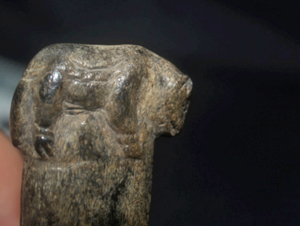
Figure 1: Knife handle with possible depiction of a dog in
harness, ca. 2000 ears BP, Ust'-Polui (Salekhard), Russia
Photo courtesy of R. Losey
The earliest possible evidence of dog transport is a knife handle (Figure 1) from the Ust’- Polui site in the Russian Arctic which dates to about 2000 years ago and appears to show a dog wearing a harness [20]. In the Eastern Arctic, the earliest evidence for the use of dog sleds is associated with the Thule people. Sleds, trace buckles, and whip shanks have frequently been found in association with dogs at Thule sites across North America after about 1000 years ago, but it is not clear if earlier Paleoeskimo cultures used dog sleds or packs [13]. Other than this there is no clear evidence of dog transport in the prehistoric world. Given the widespread distribution of dog transport in the Arctic and Great Plains regions at the time of initial European contact, it seems likely that dog transport was well established in these regions during the prehistoric period but hardware related to these activities did not preserve well.
Establishing when and where humans began using dogs for transport activities is important to archaeologists not only because it tells us something about human innovation and important technological developments, but because the use of dog transport likely had a significant impact on human mobility patterns in regions where this technology was used.
SKELETAL INDICATORS OF DOG TRANSPORT
Because archaeological evidence of dog transport is scarce, some archaeologists have suggested that we might be able to identify dogs used for transport by looking at skeletal remains [10, 13, 21, 22, 23]. It is thought that habitual stresses or habitual activities can change the skeleton in unique ways that can be identified and used as skeletal indicators of dog transport in archaeological dog skeletons. Several skeletal indicators have previously been suggested including osteoarthritis of the limbs, scapular spine fractures, and pathologies of the vertebrae [10, 13, 21, 22, 23]. The reliability of these methods for identifying archaeological dogs used for transport is not clear, however, because they were developed based on observations of archaeological dogs with unknown life histories and a single veterinary study of sled dogs from the mid-20th century.
The study presented here evaluates two spinal pathologies previously used as skeletal indicators of dog transport by other archaeologists. The first of these, spondylosis deformans, is a degenerative disease in which bony growths called osteophytes develop at the margins of vertebral endplates following damage to the adjacent intervertebral disc (see Figure 2) [24, 25, 26, 27]. In other studies, archaeologists have used high rates of this disease, and its co-occurrence with other indicators, as evidence that archaeological dogs may have been used by humans for transport activities [10, 13, 21, 22, 23].
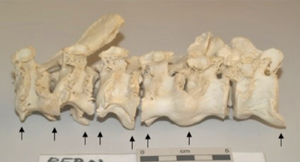
Figure 2: Thoracic vertebrae with spondylosis deformans.
Arrows indicate the presence of marginal osteophytes.
Photo courtesy of the author
The second indicator is the occurrence of bent and fractured spinous processes. Some archaeologists have speculated that the use of dogs to carry packs may put pressure on the spine and cause the spinous processes of some vertebrae to bend, fracture, or otherwise deform in response to the load [22, 23]. This suggestion is based entirely on observations of archaeological dogs with spinous processes which appear distinctly bent. Typically, spinous processes extending from the vertebral body at a 90-degree angle (see Figure 3). Past studies have used the observation of bent spinous processes, as well as high numbers of fractured spinous processes as an indicator that archaeological dogs were used for carrying packs [22, 23].
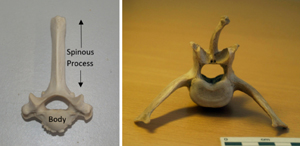
Figure 3: Thoracic vertebra with a normal spinous process (left).
Lumber vertebra with bent spinous process (right).
Photo courtesy of the author
Though several studies have used spondylosis deformans and spinous process deformations as indicators, it’s not clear if either pathology is actually linked to the use of dogs for transport. Neither pathology has been systematically tested in dogs that were not used for transport, or even in known transport dogs, so it isn’t clear if either pathology is appropriate for use as an indicator of these activities.
The use of spondylosis deformans as an indicator is particularly problematic because the disease is common in many mammals and is known to occur at especially high rates among dogs. Veterinary studies have shown that the prevalence of the disease is linked to increased age and that body size, breed, and other genetic factors may also contribute to the development of the disease [25, 27, 28, 29].
Spinous process deformations also pose problems as an indicator, largely because there has been little veterinary research on this pathology. In other words, it’s not clear how common bent or fractured processes are in dogs not used for transport so it is difficult to argue that archaeological cases are unusual or are related to a specific type of activity.
METHODS
To evaluate the reliability of these pathologies as indicators of dog transport, the occurrence of each pathology was analyzed in a sample of 155 skeletonized dogs and 241 wolves. This sample included both modern sled dogs and non-transport dogs as well as wild and captive wolves. In each individual, all cervical, thoracic and lumbar vertebrae were assessed for the occurrence osteophytes, and the degree to which they were affected by the disease.
Deformations of the spinous processes including both bent and fractured processes were also recorded. To consistently identify bent processes each spinous process was measured with a protractor. The process was considered bent if it deviated to the left or right by 10 degrees or more. Additionally, the direction and location of the bend or fracture was recorded.
RESULTS
Spondylosis deformans
Spondylosis deformans was very common in both non-transport and sled dogs and affected about 65% of all dogs in each group. Wild wolves were significantly less affected but, surprisingly, captive wolves were the most affected group, with nearly 77% of individuals affected by the disease. These findings suggest that dogs and wolves are affected by spondylosis deformans at similar rates regardless of their use for transport activities.
In both dog and wolf groups the number of individuals affected by osteophytes rose steadily as age increased (Figure 4). This pattern supports veterinary studies that have linked the disease with aging and suggests that sled dogs are not differently affected by the disease than non-transport dogs or even wolves. In addition, it likely explains the differences observed in the two wolf groups. Wolves in captivity tend to live much longer than their wild counterparts [30, 31] and these results suggest that wolves and dogs are similarly affected by the disease when they have similar lifespans and live in similar environments.
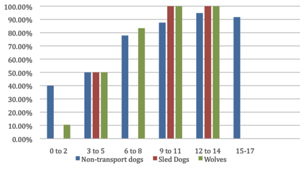
Figure 4: Spondylosis deformans in dogs and wolves of known age groups
Body size also appears to be related to the occurrence of the disease. When non-transport dogs were compared in sized based breed groups, large sized breeds were affected by osteophytes at significantly higher rates than small or medium dogs, both of which were similarly affected.
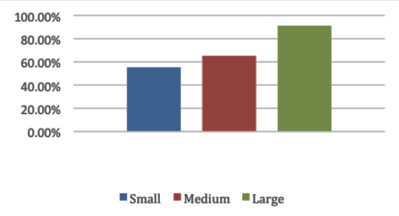
Figure 5: Spondylosis deformans in size based non-transport dog breed groups
The results of these analyses suggest that spondylosis deformans is not a reliable indicator of transport in dogs because the disease occurs at high rates in dogs and captive wolves, regardless of their use for transport activities. This study also shows that the disease is clearly related to age as well as body mass. In addition to these findings, veterinary studies have shown the disease may be more common in certain breeds and has a heritable component.
Though it remains possible that dogs used for transport are affected by a different pattern of osteophyte distribution throughout the spine than non-transport dogs, other factors such as sex appeared to influence osteophyte distribution in this study. It would be difficult to identify all possible factors that could influence distribution in individual archaeological specimens, let alone attribute the distribution pattern to one specific factor when others are present. Overall, it seems that the development of spondylosis deformans in dogs is influenced by so many different factors that it seems unreasonable to try to attribute the disease to transport related activities when it is observed among dogs found in an archaeological setting.
Spinous Process Deformations
Bent and fractured spinous processes occurred at low rates in all groups (Figure 6). Both pathologies were found most frequently among wild wolves. Dogs were affected at much lower rates. Bent processes occurred in non-transport dogs more often than sled dogs, but at about the same rate that sled dogs suffered fractures.
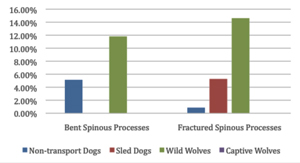
Figure 6: Spinous process deformations in dogs and wolves.
Based on the similar rates at which non-transport dogs were affected with bent processes and sled dogs affected by fractures, it seems likely that bent processes are cases of healed fractures or microfractures that cannot be observed with the naked eye. This is supported by the fact that the occurrence of bent processes increased with age in wolves. A spinous process cannot be bent in a mature individual without fracture and subsequent healing, so the best way to explain this increase among adults is to conclude that bent processes are in fact fractures.
While conducting this analysis it became clear that spinous processes deviate in multiple ways that could not be measured using the protractor method devised for this study. In addition to bending left or right, spinous processes can also appear s-shaped, twisted, or anteriorly or posteriorly compressed and so the methods used in this study may not have adequately identified all abnormal processes. Because of these methodological challenges, it’s not clear if spinous process deformities are a good indicator of load bearing in dogs. The results of the present analysis suggest they are rare in general but are more likely to occur in wolves than dogs. Additionally, there were no dogs used for carrying packs in this sample, so it is still uncertain how this form of transport affects dogs.
In her 2004 dissertation, Diane Warren observed much higher rates of bent and fractured spinous processes among archaeological dogs in the Southeastern United States and has used these pathologies to argue that the dogs there were used to carry packs. Comparison of Warren’s data to the pattern and frequency of deformities observed in the present study is difficult due to methodological differences, but it appears that there are real differences between the two data sets. Whether Warren’s dogs were more affected by spinous process deformities due to pack carrying remains uncertain.
CONCLUSIONS
The major conclusion of this study is that spondylosis deformans is not a good indicator of load bearing in dogs. The disease is simply too common in dogs and is influenced by so many different factors that it does not seem possible to attribute the presence of the pathology to a specific activity. However, the results of this analysis do give archaeologists an idea of the rates of spondylosis that should be expected for both dogs and wolves found in archaeological assemblages. Establishing these types of ranges is useful for identifying when rates are truly abnormal and may be helpful in distinguishing between dogs and wolves, or wild and captive wolves in archaeological assemblages. It also seems that high rates of spondylosis may indicate the presence of older dogs or wolves in archaeological assemblages, so spondylosis data may be useful in determining the age at which archaeological dogs died.
This analysis has also demonstrated the need for further investigation of bent spinous processes in dogs and wolves. It has been hypothesized that bent processes may in fact be the result of fractures and using technology like CT scanning or x-ray would help determine why bent processes occur. The methodological limitations of this study also demonstrate the need for a more comprehensive analysis of how often spinous process deformities occur among populations not used in transport activities so that archaeologists can better identify and describe the occurrence of unusual elements when they are found in archaeological dog specimens.
Understanding and identifying the origins of dog transport is a challenge for archaeologists due to a lack of hard evidence for the technology prior to the historic era. Though the use of skeletal remains for identifying transport dogs is appealing, skeletal abnormalities can only be useful as indicators of transport activities if they effect known transport dogs differently than dogs not used for such activities. By systematically testing and eliminating previously suggested indicators in this way, we can improve current methods for studying the use of dogs for transport activities and work towards a better understanding of the origins and history of these working dogs.
REFERENCES CITED
1 Larson, Greger, Elinor K. Karlsson, Angela Perri, Matthew T. Webster, Simon Y. W. Ho, Joris Peters, Peter W. Stahl, Philip J. Piper, Frode Lingaas, Merete Fredholm, Kenine E. Comstock, Jaime F.Modiano, Claude Schelling, Alexander I. Agoulnik, Peter A. Leegwater, Keith Dobney, Jean-Denis Vigne, Carles Vilà, Leif Andersson, and Kerstin Lindblad-Toh
2012 Rethinking Dog Domestication by Integrating Genetics, Archeology, and Biogeography. Proceedings of the National Academy of Sciences 109(23):8878-8883.
2 Savolainen, Peter
2007 Domestication of Dogs. In The Behavioural Biology of Dogs, edited by Per Jensen, pp. 21-37. CABI, Wallingford, Oxfordshire.
3 Thalmann, O., B. Shapiro, P Cui, V.J. Schuenemann, S.K. Sawyer, D.L. Greenfield, M.B. Germonpre, M.V. Sablin, F. Lopez-Giraldez, S. Domingo-Roura, H. Napierla, H.P. Uerpmann, D.M. Loponte, A.A. Acosta, L. Giemsch, R.W. Schmitz, B. Worthington, J. E. Buikstra, A. Druzhkova, A.S. Graphodatsky, N.D. Ovodov, N. Wahlberg, A.H. Freedman, R.M. Scweizer, K.-P. Koepfli, J.A. Leonard, M. Meyer, J. Krause, S. Paabo, R.E. Green, R.K. Wayne
2013 Complete Mitochondrial Genomes of Ancient Canids Suggest a European Origin of Domestic Dogs. Science 342(6160):871-874.
4 Wayne, Robert K. and Brigett M. vonHoldt
2012 Evolutionary Genomics of Dog Domestication. Mammalian Genome 23(1-2):3-18.
5 Clutton-Brock, Juliet
1995 Origins of the Dog: Domestication and early history. In The Domestic Dog: Its Evolution, Behaviour and Interactions with People, edited by James Serpell, pp. 7-20. Cambridge University Press, Cambridge.
6 Morey, Darcy F.
2010 Dogs: Domestication and the Development of a Social Bond. Cambridge University Press, New York.
7 Zeder, Melinda A.
2012 Pathways to Animal Domestication. In Biodiversity in Agriculture: Domestication, Evolution and Sustainability, edited by Paul Gepts, Thomas R. Famula, and Robert L. Bettinger, pp.227-259. Cambridge University Press, Cambridge.
8 Leonard, Jennifer A., Robert K. Wayne, Jane Wheeler, Raúl Valadez, Sonia Guillén,
Carles Vilà
2002 Ancient DNA Evidence for Old World Origin of New World Dogs. Science 298(5598):1613-1616.
9 Olsen, Stanley J.
1985 Origins of the Domestic Dog: The Fossil Record. The University of Arizona Press, Tucson.
10 Arnold, Charles D.
1979 Possible Evidence of Domestic Dog in a Paleoeskimo Context. Arctic 32(3): 263-265.
11 Damas, David (editor)
1984 Handbook of North American Indians, Vol. V. Smithsonian Institution, Washington D.C.
12 Mannermaa, Kristiina, Pirkko Ukkonen & Suvi Viranta
2014 Prehistory and Early History of Dogs in Finland. Fennoscandia archaeologica XXXI:25-44.
13 Morey, Darcy F. and Kim Aaris-Sorensen
2002 Paleoeskimo Dogs of the Eastern Arctic. Arctic 55(1):44-56.
14 Allen, Glover M.
1920 Dogs of the American Aborigines. Bulletin of the Museum of Comparative Zoology Vol. 63, No. 9. Harvard University, Cambridge.
15 Bozell, J. R
1988 Changes in the Role of the Dog in Protohistoric-historic Pawnee Culture. Plains Anthropologist 33(119):95-111.
16 Grinnell, George Bird
1920 When Buffalo Ran. Yale University Press, New Haven.
17 Lowie, Robert H.
1954 Indians of the Plains. The Natural History Press, Garden City, New York.
18 Wilson, Gilbert
1924 The Horse and the Dog in Hidatsa Culture. Anthropological Papers of the American Museum of Natural History 15(2):125-331. New York.
19 Loovers, Jan Peter Laurens.
2015 Dog Craft: A History of Gwich’in and Dogs in the Canadian North. Hunter Gatherer Research 1(4):387-419.
20 Chernetsov, Vallerii Nikolaevitch, and W. Moszynska.
1974 Prehistory of Western Siberia. No. 9. McGill-Queen’s Press-MQUP.
21 Millar, J.F.V.
1978 The Gray Site: An Early Plains Burial Ground, Vol. I and II, Parks Canada Manuscript, No. 304.
22 Snyder, Lynn M.
1995 Assessing the Role of the Domestic Dog as a Native American Food Resource in the Middle Missouri Subarea AD 1000-1840. PhD dissertation, Department of Anthropology, University of Tennessee, Knoxville.
23 Warren, Diane M.
2000 Paleopathology of Archaic dogs from the North American Southeast. BAR International Series 889:105-114.
24 Burt, Nicole M., Dyan Semple, Kathryn Waterhouse, and Nancy C. Lovell
2013 Identification and Interpretation of Joint Disease in Paleopathology and Forensic Anthropology. Charles C. Thomas, Springfield.
25 Morgan, J. P.
1967 Spondylosis Deformans in the Dog: A Morphologic Study with Some Clinical and Experimental Observations. Acta Orthopaedica 38(sup96):1-88.
26 Morgan, J. P.
1967 Spondylosis Deformans in the Dog: Its Radiographic Appearance. Veterinary Radiology 8(1):17-22.
27 Morgan, J. P., G. Ljunggren and Rosemary Read
1967 Spondylosis Deformans (Vertebral Osteophytosis) in the Dog. Journal of Small Animal Practice 8(2):57-66.
28 Carnier, P., L. Gallo, E. Sturaro, P. Piccinini, & G. Bittante.
2004 Prevalence of Spondylosis Deformans and Estimates of Genetic Parameters for the Degree of Osteophytes Development in Italian Boxer Dogs. Journal of Animal Science 82(1), 85-92.
29 Langeland, J M. and F. Lingaas
1995 Spondylosis Deformans in the Boxer: Estimates of Heritability. Journal of Small Animal Practice 36, 166-169.
30 Fuller, Todd K., L. David Mech, Jean Fitts Cochrane
2003 Wolf Population Dynamics. In Wolves: Behavior, Ecology, and Conservation, edited by L. David Mech and Luigi Boitani, pp.161-191. University of Chicago Press, Chicago.
31 Mech, L.D.
2006 Estimated Age Structure of Wolves in Northeastern Minnesota. Journal of Wildlife Management 70(5):1481-1483.
| Ed: Katherine J. Latham is an archaeologist from Omaha, Nebraska. She is a PhD student in the Department of Anthropology at the University of Alberta, in Edmonton. Her research focuses on understanding and identifying the origins of the domestic dog (Canis familiaris), as well as their working and social relationships with humans. Ms. Latham is also part of a larger international research group, Dog Archaeology that studies the origins and archaeological history of the domestic dog. |